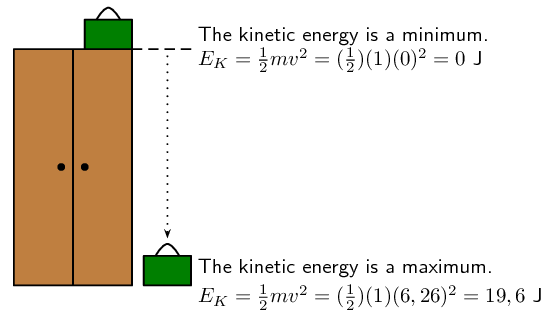Describe the relationship between an object's kinetic energy and its:
-
mass and
-
velocity
|
Previous
22.2 Potential energy
|
Next
22.4 Mechanical energy
|
Kinetic energy is the energy an object has due to its motion.
Quantity: Kinetic energy \({E}_{K}\) Unit name: Joule Unit symbol: J
Kinetic energy is the energy an object has because of its motion. This means that any moving object has kinetic energy. Kinetic energy is defined as:
\[{E}_{K} = \frac{1}{2}m{v}^{2}\]where \({E}_{K}\) is the kinetic energy (measured in joules, \(\text{J}\))
\(m =\) mass of the the object (measured in \(\text{kg}\))
\(v =\) velocity of the object (measured in \(\text{m·s$^{-1}$}\)).
Therefore the kinetic energy \({E}_{K}\) depends on the mass and velocity of an object. The faster it moves, and the more massive it is, the more kinetic energy it has. A truck of \(\text{2 000}\) \(\text{kg}\), moving at \(\text{100}\) \(\text{km·h$^{-1}$}\) will have more kinetic energy than a car of \(\text{500}\) \(\text{kg}\), also moving at \(\text{100}\) \(\text{km·h$^{-1}$}\).
You may sometimes see kinetic energy written as KE. This is simply another way to write kinetic energy. We will not use this form in this book, but you may see it written like this in other books.
Consider the \(\text{1}\) \(\text{kg}\) suitcase on the cupboard that was discussed earlier. When it is on the top of the cupboard, it will not have any kinetic energy because it is not moving:
\begin{align*} {E}_{K} & = \frac{1}{2}m{v}^{2} \\ & = \frac{1}{2}\left(\text{1}\text{ kg}\right){\left(\text{0}\text{ m·s$^{-1}$}\right)}^{2} = \text{0}\text{ J} \end{align*}When the suitcase falls, its velocity increases (falls faster), until it reaches the ground with a maximum velocity. As its velocity velocity increases, it will gain kinetic energy. Its kinetic energy will increase until it is a maximum when the suitcase reaches the ground. If it has a velocity of \(\text{6,26}\) \(\text{m·s$^{-1}$}\) when it reaches the ground, its kinetic energy will be:
\begin{align*} {E}_{K} & = \frac{1}{2}m{v}^{2} \\ & = \frac{1}{2}\left(\text{1}\text{ kg}\right){\left(\text{6,26}\text{ m·s$^{-1}$}\right)}^{2} = \text{19,6}\text{ J} \end{align*}
A \(\text{1}\) \(\text{kg}\) brick falls off a \(\text{4}\) \(\text{m}\) high roof. It reaches the ground with a velocity of \(\text{8,85}\) \(\text{m·s$^{-1}$}\). What is the kinetic energy of the brick when it starts to fall and when it reaches the ground?
The mass of the brick \(m = \text{1}\text{ kg}\)
The velocity of the brick at the bottom \(v = \text{8,85}\text{ m·s$^{-1}$}\)
These are both in the correct units so we do not have to worry about unit conversions.
We are asked to find the kinetic energy of the brick at the top and the bottom. From the definition we know that to work out \({E}_{K}\), we need to know the mass and velocity of the object and we are given both of these values.
Since the brick is not moving at the top, its kinetic energy is zero.
A herder is herding his sheep into the kraal. A mother sheep and its lamb are both running at \(\text{2,7}\) \(\text{m·s$^{-1}$}\) towards the kraal. The sheep has a mass of \(\text{80}\) \(\text{kg}\) and the lamb has a mass of \(\text{25}\) \(\text{kg}\). Calculate the kinetic energy for each of the sheep and the lamb.
the mass of the mother sheep is \(\text{80}\) \(\text{kg}\)
the mass of the lamb is \(\text{25}\) \(\text{kg}\)
both the sheep and the lamb have a velocities of \(\text{2,7}\) \(\text{m·s$^{-1}$}\)
We need to find the kinetic energy of the sheep and the kinetic energy of its lamb
Note: Even though the sheep and the lamb are running at the same velocity, due to their different masses, they have different amounts of kinetic energy. The sheep has more than the lamb because it has a higher mass.
According to the equation for kinetic energy, the unit should be \(\text{kg·m·s$^{-2}$}\). We can prove that this unit is equal to the joule, the unit for energy.
\begin{align*} \left(\text{kg}\right){\left(\text{m·s$^{-1}$}\right)}^{2} & = \left(\text{kg·m·s$^{-2}$}\right)·\text{m} \\ & = \text{N·m} \left(\text{ because Force }\left(\text{N}\right) = \text{ mass }\left(\text{kg}\right) \times \text{ acceleration }\left(\text{m·s$^{-2}$}\right)\right) \\ & = \text{J} \left(\text{ Work }\left(\text{J}\right) = \text{ Force }\left(\text{N}\right) \times \text{ distance }\left(\text{m}\right)\right) \end{align*}We can do the same to prove that the unit for potential energy is equal to the joule:
\begin{align*} \left(\text{kg}\right)\left(\text{m·s$^{-2}$}\right)\left(\text{m}\right) & = \text{N·m} \\ & = \text{J} \end{align*}A bullet, having a mass of \(\text{150}\) \(\text{g}\), is shot with a muzzle velocity of \(\text{960}\) \(\text{m·s$^{-1}$}\). Calculate its kinetic energy.
We are given the mass of the bullet m = \(\text{150}\) \(\text{g}\). This is not the unit we want mass to be in. We need to convert to \(\text{kg}\).
\begin{align*} \text{Mass in grams } ÷ 1000 & = \text{ Mass in kg} \\ \text{150}\text{ g} ÷ 1000 & = \text{0,150}\text{ kg} \end{align*}We are given the initial velocity with which the bullet leaves the barrel, called the muzzle velocity, and it is \(v = \text{960}\text{ m·s$^{-1}$}\).
We are asked to find the kinetic energy.
We just substitute the mass and velocity (which are known) into the equation for kinetic energy:
\begin{align*} {E}_{K} & = \frac{1}{2}m{v}^{2} \\ & = \frac{1}{2}\left(\text{0,150}\text{ kg}\right){\left(\text{960}\text{ m·s$^{-1}$}\right)}^{2} \\ & = \text{69 120}\text{ J} \end{align*}Describe the relationship between an object's kinetic energy and its:
mass and
velocity
A stone with a mass of \(\text{100}\) \(\text{g}\) is thrown up into the air. It has an initial velocity of \(\text{3}\) \(\text{m·s$^{-1}$}\). Calculate its kinetic energy:
as it leaves the thrower's hand.
when it reaches its turning point.
A car with a mass of \(\text{700}\) \(\text{kg}\) is travelling at a constant velocity of \(\text{100}\) \(\text{km·hr$^{-1}$}\). Calculate the kinetic energy of the car.
|
Previous
22.2 Potential energy
|
Table of Contents |
Next
22.4 Mechanical energy
|